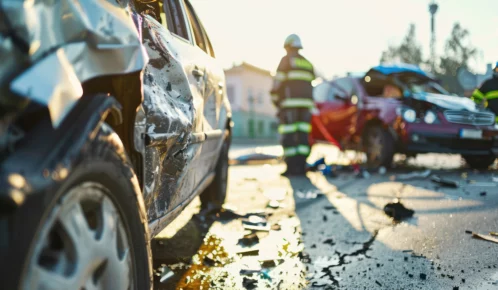Police brutality entails the use of unwarranted or excessive force on the part of police officers against civilians, with multiple types of police brutality causing injuries and other damages to the victims of these attacks. Knowing the facts about police brutality can help you determine your rights as a victim.
Table of Contents

Common Forms of Police Brutality
What is police brutality? It comes in several forms that can cause harm to arrestees and civilians. The following are among the most common forms of police brutality:
Excessive Force
Excessive force entails police officers exerting more force than is necessary when attempting to restrain, neutralize, or detain civilians. The nature of the force that officers use when engaging with civilians will vary, depending on the nature of the encounter that officers have.
For instance, if a suspect isn’t resisting arrest and an officer applies restraint to the point of causing harm, this could count as excessive force. Conversely, an officer may fire a weapon at or otherwise use lethal force with an individual who poses no direct or immediate threat, such as an individual in the process of being arrested.
Generally, excessive force involves any use of unnecessary force when civilians don’t pose a threat or possess potentially harmful weapons.
False Imprisonment
When an officer attempts to put somebody into police custody, he or she must have a valid reason for doing so. These reasons could include a valid arrest warrant or probable cause.
Probable cause is when an officer either has reason to believe a crime is being committed or has witnessed someone actively committing a crime. While an officer may believe that he or she was within reason to arrest you based on certain circumstantial evidence or something the officer witnessed, this information could be invalid and give you the basis to claim false imprisonment.
Malicious Prosecution
If police officers want to begin any type of criminal proceedings against individuals, i.e., prosecution, they need to have enough evidence to show that there are grounds for these proceedings. If they don’t have enough evidence or any other basis for beginning criminal proceedings, the suspected criminal may be able to claim malicious prosecution against the offending officer. In turn, the victim would be able to potentially recover a combination of financial and personal damages resulting from the experience of malicious prosecution.
Who Are the Most Common Victims of Police Violence?
A report from The Washington Post found that of the over 7,000 fatal police shootings that have occurred in recent years, the most common victims are people of color.
Since January 1, 2015, police fatally shot white victims at a rate of 15 per one million, while Black victims suffered fatalities at a rate of 38 per one million and Hispanic victims suffered 28 fatalities per one million. These police brutality statistics show that Black and Hispanic communities are more likely to experience fatal police encounters than other demographics.
Also, according to The Washington Post, 95% of deaths resulting from police violence are men. The majority of victims are between 20 and 40 years old, making most victims likely to be of younger demographics.
10 Interesting Facts About Police Brutality You Should Know
In addition to the above information, the following are some essential police brutality facts:
1. Police Brutality Is Commonplace
According to the aforementioned Washington Post report, police shoot and kill around 1,000 people per year in the U.S.
2. Police Brutality Predominantly Targets Lower-Class Citizens
The police not only attack people of color more frequently, but studies have also shown that police tend to target people with low-income backgrounds. One of the reasons for this commonplace brutality among the poor and lower class is the lack of resources these civilians have compared to people of middle- or upper-class backgrounds. Specifically, they may not have access to good legal representation or have the same level of status and influence in the community to stand up to police, encouraging officers to exploit these civilians more frequently.
3. The Murder of George Floyd Has Ignited a Fight Against Police Brutality
On May 25, 2020, African-American citizen George Floyd died as a result of fatal police brutality. The courts convicted Derek Chauvin for Floyd’s murder as a result of police brutality. Floyd’s death resulted in a resurgence of protests against police brutality that echo past protests, including those following the attack of Rodney King in the early 1990s.
4. Victims of Police Brutality Can Recover Many Damages
If someone suffers police brutality in America, he or she may be able to file a lawsuit against the officers who committed the brutal acts for various damages sustained. There are many damages that victims of police brutality sustain, including injuries and financial losses.
Some specific damages involved in police brutality cases include:
- Hospital bills
- Medical expenses for ongoing treatment
- Lost income resulting from injury recovery periods or disabilities that prevent the victim from returning to work
- Lost earning capacity
- Property damage, such as damage to cell phones, vehicles, or other belongings
- Pain and suffering, including physical pain and psychological distress
5. A Large Number of Police Officers Receive a Misconduct Complaint
Recent police brutality statistics from a Bureau of Justice Statistics Special Report show that 9.5% of police officers in urban locations have someone file a misconduct complaint against them to their superiors. This statistic helps prove that there is a current epidemic of police brutality in the country.
6. Race Remains a Basis for Harassment
Research from the National Institute of Justice found that around 25%, or one in four, officers have reported observing a colleague harassing citizens “most likely” because of their race.
7. You Don’t Need to Be Innocent of a Crime to File a Police Brutality Lawsuit
People often believe that they’re unable to take action against officers for police brutality because they have committed a crime. However, individuals can still file a lawsuit against liable officers if they suffered from unreasonable use of force and police brutality.
8. New Mexico Is the State With the Highest Rate of Fatal Police Violence
Data from The Lancet, a reputable medical journal, conducted a study looking at the states that were most likely to experience instances of fatal police violence. The study involved an analysis of data from many key sources, including multiple police violence databases and the USA National Vital Statistics System (NVSS).
According to all data collected, New Mexico was the state that experienced the highest rate of deadly police violence in recent years, with the state experiencing 0.87 deaths per 100,000 people. Oklahoma and Alaska followed suit, with Oklahoma seeing 0.82 deaths per 100,000 and Alaska observing 0.79 deaths per 100,000.
In contrast to these rates, the states that saw the lowest rates of fatal police violence included Massachusetts, New York, and Rhode Island.
9. Officers Who Engage in Police Brutality Aren’t Likely to Face Prosecution and Conviction
Data from criminal justice expert Philip Stinson concluded that officers are less likely to face charges and convictions when they commit manslaughter or murder in cases involving excessive force. Specifically, of all the officers Stinson looked at in 2021, a mere 21 officers faced charges of manslaughter or murder due to deadly use of force, which was still higher than numbers seen in previous years.
Additionally, Stinson found that only 2% of officers who killed citizens on the job faced any criminal charges as a result of their actions.
10. Multiple Factors Contribute to Rises in Police Brutality
There are several main reasons the rates of police brutality remain persistent and continue to increase. According to various sources of data, some of the biggest factors that lead to police violence include:
Gun Ownership
As a growing number of people possess firearms in the U.S., the risk of police violence also increases. If officers notice that a civilian possesses a firearm, this could lead to an increased likelihood of the officer using violence to disarm him or her.
Decentralization of Law Enforcement Agencies
According to a Department of Justice survey from 2016, there are at least 12,000 independent law enforcement agencies and another 3,000 independent sheriff’s offices. These offices and agencies operate with minimal oversight and, subsequently, without superior counterparts to hold them accountable. Also, the majority of those agencies and local police departments employee only 50 officers or fewer.
Long Roots in Discrimination
Adding to the continuation of police violence is its extensive history going back to the origin of the U.S. Police departments used to exist primarily to control both Native American populations and slaves, with violence extending from that control and officers’ prejudices. Over the years, violence has continued to develop and remains a part of many police forces today.
What Could Help Reduce Instances of Police Brutality in America?
There are multiple steps that may help to reduce the risk of police violence affecting civilians in the future. Some methods to help reduce violence in police departments include the following:
- Publishing officers’ arrest data, along with any information about the use of force, such as injuries and fatalities resulting from this force.
- Collecting racial bias data.
- Introducing better standards for use of force.
- Keeping close track of wandering officers to prevent agencies and departments from hiring officers with problematic backgrounds that gave grounds for dismissal.
- Conducting objective third-party investigations into any reports of serious police misconduct or excessive force, which can identify if the officer actually used excessive force or engaged in other inappropriate behavior.
- Eliminating the ability for officers to become immune against allegations of excessive use of force and other types of violations.
What Is a Police “Code of Silence?”
Many police departments follow a police code of silence that helps develop a sense of comradery among police officers, but it can come at the detriment of civilians’ well-being and safety. This code of silence essentially keeps officers from speaking out about or punishing any wrongdoing on the part of police officers.
While a code of silence may strengthen the bond between officers, it can prevent officers from facing any consequences for their actions when they engage in any form of police brutality. Often, police adhere to the code of silence out of fear of repercussions from those within the department after witnessing incriminating behavior and acts. For instance, officers may not speak up if they fear backlash for reporting internal crimes such as drug trafficking, discrimination, battery, or assault.
As a result, the code of silence has been a factor in many cases involving police brutality over the years. Multiple officers may collaborate to commit brutality, preventing any of them from speaking up in adherence to the code of silence.
What Evidence Do You Need to Prove Police Brutality in Chicago?
If you believe that one or more officers engaged in police brutality and caused harm to you or a loved one, you need to prove the officers’ misconduct. The following are some critical steps to take to prove police brutality in a Chicago police lawsuit:
A Description of the Misconduct
If you believe that any form of misconduct has taken place at the hands of police, one of the first steps to take is to write down the details of the incident. How did the incident begin, and what could have provoked the officer to commit police brutality? Describe all aspects of the incident in depth, including every event in chronological order, along with officers’ names and other identifying details such as badge numbers and physical appearance.
Witness Statements
Another effective way to prove police misconduct and brutality is to gather statements from any witnesses present at the time of the incident. Make sure you’re able to get the contact information of all witnesses, but a lawyer may be able to help with this if you’re unable to reach out to witnesses after the incident.
Witnesses in these cases could include bystanders in public areas, friends, families, or other police officers.
Photographic or Video Evidence
Many instances of police brutality are provable through the review of photographic and video evidence collected at the time of the incident. For example, witnesses may take photos of the scene, which they may later submit to attorneys or police departments as evidence of police brutality. Other forms of visual evidence may come directly from the police officers involved, including bodycam and dash cam footage that can help piece together the events leading up to and during the brutality. Closed circuit television (CCTV) surveillance footage may also be in certain public areas, including streets or buildings.
Other Related Evidence
If you have any additional items to present in a potential police brutality case, you should also collect and preserve these. Other evidence may include everything from damaged property to blood-covered clothing or other materials that could support your claims.
When Should You Contact a Chicago Police Brutality Lawyer?
If you believe that police brutality has occurred in or around Chicago and you want to build a case against liable officers or departments, you should reach out to a personal injury lawyer in Chicago to discuss a possible lawsuit.
An attorney will be able to review the details of your case and determine the options available to you. You may also learn some additional facts about police brutality that help you better identify whether police brutality occurred in your case.



